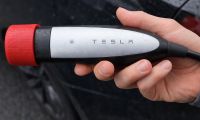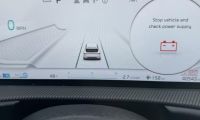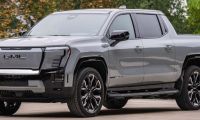One of the questions related to electric vehicles is the disposition of the battery packs after a few years when capacity depletes shortening the driving range. Will the battery pack just go to a landfill, or can they be put to another use? Today Nissan announced it was working with ABB, 4R Energy and Sumitomo, to evaluate the re-use of lithium-ion battery packs currently in use in Leaf models.
It's known that after a few years of use, battery pack capacity shrinks resulting in shorter driving distances. When brand new Nissan Leaf has a 100 mile or so range, but in a few years this will shrink to 80 miles range, which is still significant but many will want a new battery pack. Especially if promised longer range battery packs come into existence and especially if Nissan implements a drop in replacement battery packs with new battery technology. In any case, while the battery pack won't have enough remaining capacity to be used for use in a car, it still store electricity. Many have noted over the years that electric car battery packs could, in principle, be reused for other purposes.
The companies aim to "evaluate and test the residential and commercial applications of energy storage systems or back-up power sources using lithium-ion battery packs reclaimed from electric vehicles after use."
"It’s important to Nissan that we manage the complete lifecycle of the electric vehicle battery pack, even beyond its use in a Nissan car," said Ken Srebnik, senior manager, NNA Corporate Planning. "Innovations in energy storage systems are becoming more viable as the electric grid gets smarter, and Nissan is proud to work with ABB, 4R Energy and Sumitomo to help bring these possibilities to market."
Energy storage systems are expected to become a key part of the smart grid, where it's hoped to contribute to greater efficiency, reliability, performance and facilitate integrating renewable energy into the grid. Energy storage systems can make intermittent energy sources like solar or wind power more feasible. For years small scale battery backup systems have been used for things like emergency lights and critical systems. As the smart grid is implemented, large scale energy storage systems are expected to smooth out electricity demand as it fluctuates during the day. A large scale energy storage system is essentially a large battery pack, along with technology to interface with the smart grid. The battery manufacturers are selling not just to the automakers but energy storage applications. For example A123 Systems, a battery supplier for several automakers, announced in December two smart grid projects including a 1 megawatt-hour system for the Maui Smart Grid Project, and a 2 megawatt-hour system for NSTAR.
We wish them luck but there are several issues to solve for this to become practical.
There is no consistency in the battery packs from different automakers. Each one has different battery chemistry, different battery management characteristics, different shapes (form factor) and so on. Reuse of battery packs from any automaker will have to accommodate these differences.
What is the residual value of a battery pack after ten years and it has 70% or so remaining capacity? Who gets the money for reselling the battery pack at its end of useful life? Can the residual value of the battery pack be used to decrease electric car purchase price? What will be the most economically feasible use for energy storage systems in general, not only the ones built out of electric car battery pack reuse?
About the reporter: After 22 years in Silicon Valley's software industry David Herron is now writing about green transportation (electric vehicles) from Silicon Valley. David has built a number of electric bicycles, scooters, a motorcycle, and recently completed an electric 1971 Karmann Ghia conversion. He also runs the popular electric vehicle discussion forum, visforvoltage.org, and is the author of the book "Node Web Development".











